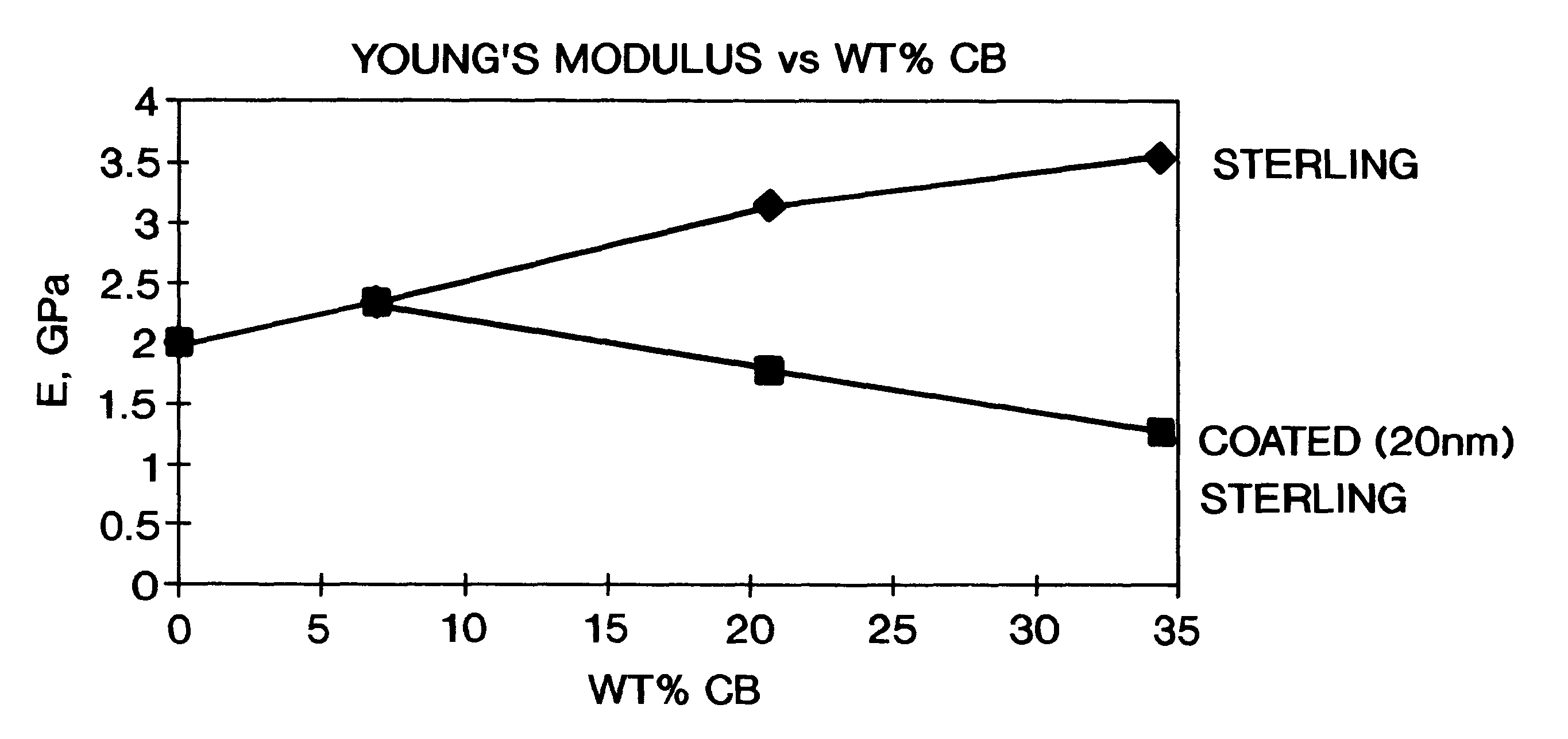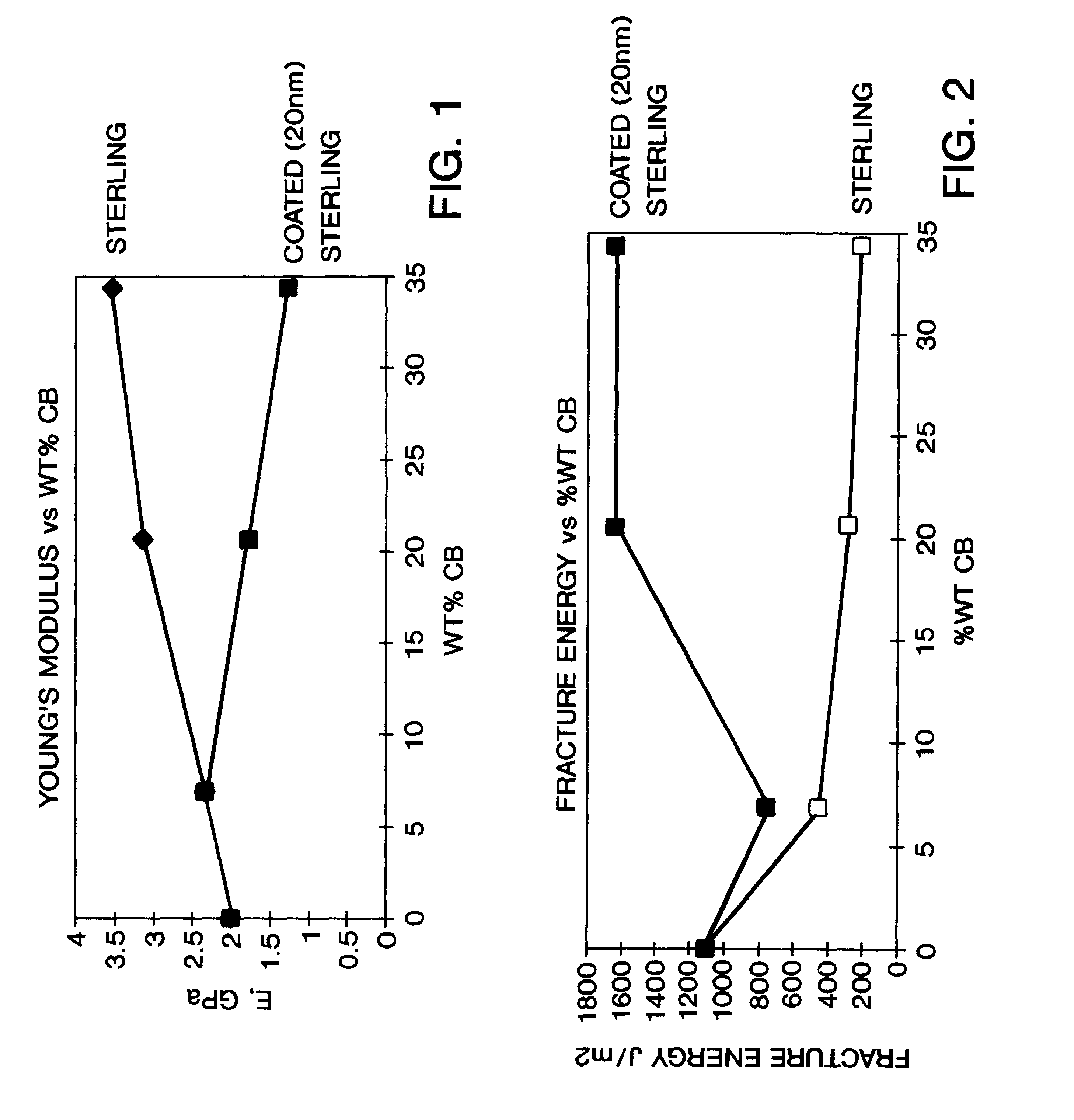Polymer coated carbon products and other pigments and methods of making same by aqueous media polymerizations or solvent coating methods
- Summary
- Abstract
- Description
- Claims
- Application Information
AI Technical Summary
Benefits of technology
Problems solved by technology
Method used
Image
Examples
example 1
Homopolymers of styrene (PS), acrylonitrile (PAN) and glycidyl methacrylate (PGMA), and a terpolymer of the three of them (PS / AN / GMA) were prepared by solution polymerisation in toluene at a solvent to monomer ratio of 70:30 by weight. AZBN was used as the initiator at a level of 0.1% by weight of monomer. The polymerisation was allowed to proceed for 16 hours at 60.degree. C. under a nitrogen atmosphere. The resulting polymers were separated and purified by precipitation into a large excess of petroleum ether (60 / 80) and dried at 40.degree. C. under vacuum to constant weight. The comonomer compositions used are given in Table 1.
The structure of the terpolymer prepared had the following structure: ##STR1##
Coating of the carbon black or the modified carbon black particles was achieved via a solution evaporation method. There were three main steps in the procedure for coating the particles: first, the dissolution of the terpolymer (PS / AN / GMA) in a suitable solvent (100:5 wt % solvent:...
example 2
Investigations were carried out on the use of emulsion polymerisation techniques for in situ formation of polymer on the surface of modified carbon black. Styrene was selected as the monomer and 4,4'-azobis(4-cyanopentanoic acid) as the initiator. The carbon black was Sterling.RTM. 4620 grade (Cabot Corporation) with --C.sub.6 H.sub.4 SO.sub.3 Na groups attached to the carbon black.
Three emulsion polymerization's were carried out, with the only difference being the amount of initiator used. The formulations used are given in Table 2B. The amount of polymer used was calculated to give a 20 nm coating, based upon the surface area and volume of the equivalent non-porous sphere with the same diameter as the modified carbon black.
The polymerization's were preformed under nitrogen in a 5-necked flanged reaction flask at 70.degree. C. Accurate weights of modified carbon black were dispersed in water (20 g) in the reaction flask. The contents of the reaction flask were stirred continuously ...
example 3
Studies were carried out in order to synthesise a terpolymer (PS / BA / GMA) of styrene, butyl acrylate and glycidyl methacrylate with a lower T.sub.g than the one described in Example 1.
Styrene (Aldrich, 98%) was washed several times with 10% sodium hydroxide solution in a separating funnel, then several times with distilled water. The inhibitor-free monomer was dried over anhydrous calcium chloride before being distilled under nitrogen at reduced-pressure. Butyl acrylate (Aldrich, 97%) was washed several times with 2% sodium hydroxide solution in a separating funnel, then several times with distilled water. The inhibitor-free monomer was dried over anhydrous calcium chloride before filtering off. Azo-bis(isobutyronitrile) (AZBN) was purified by forming a saturated solution in toluene at 30.degree. C. and then cooling the solution to 0.degree. C. in an ice-water bath. Glycidyl methacrylate (Aldrich, 97%) was used as supplied.
The terpolymer was prepared by solution polymerisation in tol...
PUM
| Property | Measurement | Unit |
|---|---|---|
| Time | aaaaa | aaaaa |
| Thickness | aaaaa | aaaaa |
| Thickness | aaaaa | aaaaa |
Abstract
Description
Claims
Application Information
 Login to View More
Login to View More - R&D
- Intellectual Property
- Life Sciences
- Materials
- Tech Scout
- Unparalleled Data Quality
- Higher Quality Content
- 60% Fewer Hallucinations
Browse by: Latest US Patents, China's latest patents, Technical Efficacy Thesaurus, Application Domain, Technology Topic, Popular Technical Reports.
© 2025 PatSnap. All rights reserved.Legal|Privacy policy|Modern Slavery Act Transparency Statement|Sitemap|About US| Contact US: help@patsnap.com



